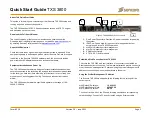
Daqu — Manual
3.6
Analog Active Sensors
has its own built-in electronics, which takes care for voltage fluctuations. This
makes their signal more stable and robust.
Most of these sensors fall into one of two groups:
Sensors with voltage output.
Sensors with current output.
3.6.1
Voltage Output
Daqu can connect sensors with varying voltage output signal in range of 0-5
V. These sensors can connect to B, D and E channels.
An active sensor with voltage output usually has three wires. +5/+12 V
sensor input wire is connected to appro5/+12 V Daqu pin, ground
wire to GND Daqu pin and the sensor signal output wire to one of B, D or E
channels.
The sensor signal output voltage must be limited to 5 V. Higher voltage may
permanently damage Daqu.
A few different standards appear within this voltage range.
0.5 – 4.5 V
output range is the most frequent one. The sensor outputs
0.5 V when not loaded and 4.5 V when it is maximally loaded.
0 – 5 V
output range. Sensor outputs 0.0 V when not loaded and 5 V
on maximal load.
0.25 – 4.75 V
output range. Sensor outputs 0.25 V when not loaded
and 4.75 V on maximal load.
Figure 9 illustrates an example of active sensor with voltage output connected
to a B channel. The sensor requires 12 V to operate, but some other sensor
might require 5 V. Always check sensor’s specifications.
3.6.2
Current Output
Some active sensors have varying current. The current vary between 4 mA
when sensor is unloaded and 20 mA when sensor is fully loaded. These sensors
can connect to D channels, which have an internal 120 Ω resistor. The resistor
is automatically engaged when current output sensor is selected.
19
©
Kanardia
2019
Содержание Daqu
Страница 1: ...Daqu EMS Box Installation Manual Kanardia d o o January 2019 Kanardia d o o...
Страница 2: ......
















































